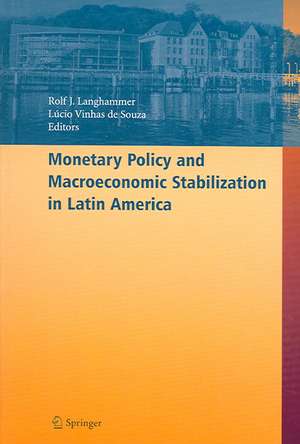Monetary Policy and Macroeconomic Stabilization in Latin America
Editat de Rolf J. Langhammer, Lúcio Vinhas de Souzaen Limba Engleză Hardback – 18 iul 2005
| Toate formatele și edițiile | Preț | Express |
|---|---|---|
| Paperback (1) | 943.25 lei 6-8 săpt. | |
| Springer Berlin, Heidelberg – 13 oct 2010 | 943.25 lei 6-8 săpt. | |
| Hardback (1) | 949.42 lei 6-8 săpt. | |
| Springer Berlin, Heidelberg – 18 iul 2005 | 949.42 lei 6-8 săpt. |
Preț: 949.42 lei
Preț vechi: 1157.82 lei
-18% Nou
Puncte Express: 1424
Preț estimativ în valută:
181.70€ • 188.25$ • 151.64£
181.70€ • 188.25$ • 151.64£
Carte tipărită la comandă
Livrare economică 21 martie-04 aprilie
Preluare comenzi: 021 569.72.76
Specificații
ISBN-13: 9783540255833
ISBN-10: 3540255834
Pagini: 272
Ilustrații: X, 256 p.
Dimensiuni: 155 x 235 x 22 mm
Greutate: 0.56 kg
Ediția:2005
Editura: Springer Berlin, Heidelberg
Colecția Springer
Locul publicării:Berlin, Heidelberg, Germany
ISBN-10: 3540255834
Pagini: 272
Ilustrații: X, 256 p.
Dimensiuni: 155 x 235 x 22 mm
Greutate: 0.56 kg
Ediția:2005
Editura: Springer Berlin, Heidelberg
Colecția Springer
Locul publicării:Berlin, Heidelberg, Germany
Public țintă
ResearchDescriere
Latin America is a very important region of the globe, which has been buffeted by successive waves of economic instability within the last decades. These waves have caused several episodes of hyperinflation or near hyperinflation, and several currency and financial crises, which, in certain moments, have even spilled over and affected other emerging markets. This has resulted in huge costs in terms of lost potential growth, and, as is inevitable, the markets most affected by this have been the least capable of defending themselves. In a region plagued by still considerable rates of social exclusion, with some of the highest rates of income concentration in the whole globe, the human costs of these crises have been very substantial. Starting in the early 1990s, the slow implementation of reforms, plus the resumption of more sustained growth—to a substantial degree linked to the increase in commodity prices, especially since the early 2000s—seems to have resulted in a more stable situation. Initially, in early reformers like Chile, later in the larger economies of the region, like Brazil and Mexico, a consensus— embraced by both sides of the political spectrum—towards integration in global markets, both in their trade and financial components, floating exchange rates, independent monetary authorities, and sustainable fiscal policies has emerged.
Cuprins
Reducing Inflation through Inflation Targeting: The Mexican Experience.- Comment on Manuel Ramos-Francia and Alberto Torres.- How Has NAFTA Affected the Mexican Economy? Review and Evidence.- Comment on M.A. Kose, G.M. Meredith, and C.M. Towe.- Argentina: Monetary Policy by Default.- Comment on George T. McCandless.- Do Exchange Rates Matter in Inflation Targeting Regimes? Evidence from a VAR Analysis for Poland and Chile.- Comment on Felix Hammermann.- Argentina and Brazil Risk: A “Eurocentric” Tale.- Comment on Jorge Braga de Macedo and Martin Grandes.- Macroeconomic Shocks, Inflation, and Latin America’s Labor Market.- Comment on Ana Maria Loboguerrero and Ugo Panizza.- Monetary Policy Rules in Emerging Market Economies: Issues and Evidence.- Comment on M.S. Mohanty and Marc Klau.









